 |
|
by Robert W. Lebling and Donna Pepperdine
Photographed by Donna Pepperdine
Excerpted with permission from Natural Remedies of Arabia. Robert W. Lebling and Donna Pepperdine. 2006, Al-Turath/Stacey International, 1-905299-02-8 (North America: Interlink Books, www.interlinkbooks.com).
 hether you are in Doha, Dubai, Manama, Salalah, Jiddah or an obscure country village, when you step into an herbal medicine shop or wander through the traditional suqs (markets), you will find vendors of herbs, spices, bark, twigs, rocks and salt intended for culinary, cosmetic or medicinal purposes. hether you are in Doha, Dubai, Manama, Salalah, Jiddah or an obscure country village, when you step into an herbal medicine shop or wander through the traditional suqs (markets), you will find vendors of herbs, spices, bark, twigs, rocks and salt intended for culinary, cosmetic or medicinal purposes.
As you gaze at the piles of twisted bark or the varied combinations of dried flowers, you may wonder: What are these products? Where do they come from? How are they used locally?
These fascinating items whisper tales of the ancient trade routes, for many still come to Arabia from India, China, Indonesia, Egypt, Syria and other exotic locations, and are distributed across the Peninsula through existing commercial networks. Others are harvested locally, some under harsh desert conditions, and have their own fascinating stories to tell.
The people of the Arabian Peninsula have, for centuries, combined goods obtained by trade and barter with a prudent use of local plants and have developed a rich heritage of folk medicine.
Many of the natural remedies presented here are the result of a questionnaire distributed throughout the Arabian Peninsula in early 2002. The questionnaire, printed in both Arabic and English, asked families to explain how they, as well as their mothers and grandmothers, use various herbs, spices and other substances in natural healing. It also requested specific remedies for conditions such as headache, colds and coughs, sore throats, hair loss, general fatigue, childbirth and so on. We present their generous responses, which have helped to unlock many of the mysteries of local medicinal herb shops and reveal unique insights into the natural remedies of Arabia.
|

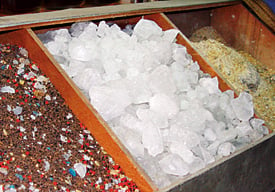 Arabic: Shabba, Shabb;
Arabic: Shabba, Shabb;
Other English: Potassium Alum, Potash Alum
First-time visitors to Middle Eastern markets may be puzzled to see piles of stones displayed prominently among the herbs and spices. One of them is alum, a crystal-white mineral often imported from China. Alum is a compound of several metals, including aluminum. It is an astringent, widely used in the Middle East to control bleeding and to clean and heal wounds. Shabba powder is mixed with henna for skin decoration, and when applied to the underarms, it acts as a deodorant. Alum is not ingested, nor is it used in cooking.
Did you know?
- In ancient Babylon, physicians used alum in a mouthwash, as a styptic, as a pessary for menorrhagia, as a nasal douche, and as a treatment for itchy scabs, gonorrhea and purulent ophthalmia. Greek and then Arab medical authorities continued these practices, and went on to use alum for the treatment of leprosy, bad gums, pustules and ear trouble.
- The alums are valuable in paper manufacturing, textile dyeing, fireproofing, water purification, and in medicine as astringents, styptics and emetics.
- The Alum Mountain, in Bulahdelah, Australia, is the only known above-ground outcrop of alum stone (alunite) in the world.
- Using shabba deodorant stones is considered safe and will not cause high levels of aluminum in your system. This is because potassium alum molecules have a negative ionic charge, and the aluminum is unable to pass through cell walls.
- Bauxite, the ore from which alum is drawn, can be purified and converted directly into alum.

Arabic: Anisun, Yansun, Yansoon Pimpinella anisum Umbelliferae/Apiaceae (Parsley Family)
From cookies to colds, this tiny, aromatic, gray-brown seed—often called aniseed—serves families across the Arabian Peninsula. Saudi merchants import much of their aniseed from Syria and India. Anise also grows in Egypt, Cyprus, Crete and on the Eastern Mediterranean coast.
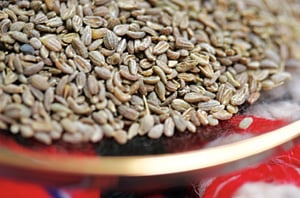 |
| LINDA LEBLING |
How to use: 1) For tea, simmer one teaspoon of aniseed in a cup of water for about 10 minutes. Strain and drink; 2) Grind seeds to powder for use in baking; 3) Chew the seeds to freshen the mouth and aid digestion.
In the kitchen: Licorice-flavored aniseed provides subtle flavor to cookies and other sweets.
Remedies across Arabia: Anise is a popular folk medicine, with a long tradition in Islamic pharmacology. It is used to treat general abdominal pain, colic, indigestion, menstrual cramping, coughs and headaches. It is also believed to clean the urinary system and prevent inflammations. Anise has aromatic, diaphoretic, relaxant, stimulant, tonic, carminative and stomachic properties.
Did you know?
- Anise is sometimes confused with fennel (Foeniculum vulgare), particularly the Iranian varieties, which are quite similar in appearance and flavor.
- An oil distilled from anise is what gives licorice candy its flavor.
- Anise is a key ingredient of supari, the digestive spice mix served after a curry meal.

Arabic: Arak, Rak;
Other English: Toothbrush Tree, Mustard Tree, Saltbush Salvadora persica L.; Salvadoraceae
 Have you ever wondered how people cleaned their teeth before the invention of the toothbrush? One answer is the miswak! A miswak (plural: masawik) is a fibrous stick prepared from the root of the arak tree. It has antiseptic and astringent properties which help clean and protect the teeth and gums. A high-quality miswak has a strong, pungent smell. It is pale yellow or cream in color. It is moist and flexible.
Have you ever wondered how people cleaned their teeth before the invention of the toothbrush? One answer is the miswak! A miswak (plural: masawik) is a fibrous stick prepared from the root of the arak tree. It has antiseptic and astringent properties which help clean and protect the teeth and gums. A high-quality miswak has a strong, pungent smell. It is pale yellow or cream in color. It is moist and flexible.
The Prophet Mohammad, founder of Islam, recommended the miswak to his followers. He used it to sweeten his breath during fasting and advised its use prior to prayer. This practice is still popular in Arabia today.
The arak is a short evergreen tree that grows in sandy and arid areas of the Middle East and Africa. Sheep and goats like to nibble its leaves.
How to use: Soak the root in water for a few hours to soften the natural fibers. Then scrape off five to 10 millimeters (¼–½) of bark from the tip and gently chew until fibers have separated and the root becomes brush-like. Clean the teeth by rubbing the miswak up and down and sideways as you would a conventional plastic toothbrush. When the fibers become overused, simply cut off the tip of the miswak, scrape off more bark and continue to use as before. To retain freshness, keep miswak in the refrigerator or soak in water.
Did you know?
- Arak roots contain triclosan, an effective antibacterial used in modern toothpastes. Other ingredients include fluoride, vitamin C, alkaloids and small amounts of tannins and flavenoids.
- A herbal toothpaste with pure miswak extract (made by a hygiene-products company in India) is currently marketed in Saudi Arabia and other countries of the region.
- Other natural toothbrush sources, when arak is not available, include the peelo tree, the olive tree, the bitam tree, the walnut tree, the neem tree or any bitter tree that is not harmful or poisonous in any way!

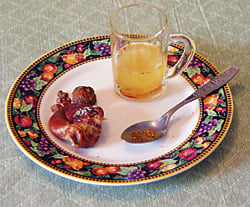 Arabic: Haltita, Hiltit;
Arabic: Haltita, Hiltit;
Other English: Asafoetida, Giant Fennel, Devil’s Dung, Stinking Gum, Food of the Gods Ferula assa-foetida or F. asafoetida; Umbelliferae/Apiaceae (Parsley Family)
When the doorbell rang, Khalid knew that his grandmother had arrived with her infamous family remedy: the foul-smelling gum resin of the asafetida plant. His mind raced to find an excuse, any excuse, to avoid taking it. He felt uncertain that the effort required to swallow the bitter substance was worth the cure. Yet he knew his grandmother would be firm. Her words still echoed to him from times of past sickness: “You know, Khalid, asafetida has been used for ages as an effective medicine in the Arab world. It works mainly to improve the digestive system, but it’s also used as a pain-reliever, a cough medicine and a blood thinner. We’ll use it to treat your upset stomach.” Khalid had no choice but to agree—and he soon felt better. In Saudi Arabia today, families still turn to asafetida as a “last-resort” treatment for coughs, colds, fevers and stomach discomfort. It is not the most popular home remedy; parents must coach their children to hold their nose and swallow quickly in order to tolerate the strong smell and bitter taste.
How to use: 1) Melt in hot water and drink; 2) Grind or crush the lump resin into powder or melt it in liquid and use sparingly as a cooking spice.
In the kitchen: Despite its sulfurous smell, asafetida, when cooked, imparts a surprisingly pleasant flavor to many foods. In Indian cuisine, it is a substi- tute for onion or garlic. Use in small amounts. The powdered form is milder than the resin, because it is normally blended with rice flour. The resin should be fried in hot oil before using. A pea-sized quantity is enough to flavor a large pot of lentils or vegetables. Store asafetida in an air-tight container.
Remedies across Arabia: Asafetida is available in Middle Eastern herb shops and can be purchased in lump resin or powdered form.
Did you know?
- Alexander the Great is credited with carrying asafetida west in the fourth century BC, following his expeditions into the Persian Empire (modern Afghanistan).
- The famous ancient Roman gourmet Apicius (first century) used asafetida in over half of his recipes.
- The British explorer Charles Doughty, who traveled throughout Arabia in the mid-19th century, called asafetida “a drug which the Arabs have in sovereign estimation.”
- Asafetida is native to Iran and western Afghanistan.
- Modern herbalists regard asafetida as a sedative, antispasmodic and circulatory agent. It is also known to relieve intestinal and stomach upsets.
- Asafetida is much used in the Ayurvedic tradition and is also popular in Indian vegetarian cooking.
- Al-Kindi, an Islamic scholar of the ninth century, used asafetida to counter phlegm and treat sore throat, tooth pain, rheumatism and nervous conditions, and also as an aphrodisiac.
- Asafetida gets its name from the Persian aza, for mastic or resin, and the Latin foetidus, for stinking.

Arabic: Mauz Musa sapientum; Musaceae (Banana Family)
The banana plant is the world’s largest herb. It is often mistaken for a tree, but does not have a woody trunk or boughs. It springs from an underground rhizome to form a false trunk three to six meters (10–20') high and is crowned with a rosette of 10–20 beautiful, oblong banana leaves.
 History credits Arab traders with giving the banana its popular name. Although there are several hundred varieties which differ in taste, color, form and size, Arab traders noted that bananas growing in Africa and Asia were small, about the size of a man’s finger, and so called them banan, which means “fingertips” in Arabic. “Banana” is the singular form.
History credits Arab traders with giving the banana its popular name. Although there are several hundred varieties which differ in taste, color, form and size, Arab traders noted that bananas growing in Africa and Asia were small, about the size of a man’s finger, and so called them banan, which means “fingertips” in Arabic. “Banana” is the singular form.
Bananas are rich in potassium, riboflavin, niacin and dietary fiber. They also contain vitamins A and C and some calcium and iron. Bananas are a quick source of energy.
How to use: In banana-producing countries, vegetables and spices are sometimes wrapped in banana leaves and then steamed. Banana leaves are used as serving plates, as tablecloths and as barriers between a wood fire and a pot. They are even used for thatching roofs and making rope.
In the kitchen: Bananas can be eaten fresh or dried. The dried fruit can be ground into a nutritious banana flour.A very old and traditional breakfast in Makkah is omelet with banana. Masoub, also featuring the banana, is currently a popular Hijazi breakfast dish. Kanafa with banana is a delicious dessert.
Remedies across Arabia: For diarrhea, use cornstarch and water; yogurt; tea leaves; mashed potatoes; bananas.
Did you know?
- Hundreds of banana varieties thrive in the tropics. Bananas grow in Egypt, Yemen, Oman and other Arab countries. In the Nile River, near Luxor, Egypt, local boats sail to Gazirat al- Mauz (“Banana Island”), where visitors can sample fruits from a large banana orchard.
- The banana has been cultivated in India for at least 4000 years. Bananas are widely used in Indian folk medicine for the treatment of diabetes mellitus.

Arabic: Habba Souda, Habbat al-Barakah;
Other English: Fennel Flower, Black Cumin Nigella sativa; Ranunculaceae (Buttercup Family)
 Native to the Mediterranean and grown throughout the Middle East and parts of Asia, Nigella sativa is cultivated for its seeds, which are known as the “seeds of blessing.” For the Arabs, black seed is not only a food but also a valued traditional medicine that has long been used to treat such ailments as asthma, flatulence, polio, kidney stones, abdominal pain and so on. It has served as an important health and beauty aid for thousands of years.
Native to the Mediterranean and grown throughout the Middle East and parts of Asia, Nigella sativa is cultivated for its seeds, which are known as the “seeds of blessing.” For the Arabs, black seed is not only a food but also a valued traditional medicine that has long been used to treat such ailments as asthma, flatulence, polio, kidney stones, abdominal pain and so on. It has served as an important health and beauty aid for thousands of years.
According to tradition, the Prophet Muhammad described black seed as a cure for every disease except death. The great physician Ibn Sina (980–1037), better known as Avicenna, stated that black seed works as an expectorant, stimulates the body’s energy and helps overcome fatigue and dispiritedness.
How to use: 1) Eat black seeds plain; 2) Eat a teaspoon of black seed mixed with honey; 3) Boil black seed with water. Strain and drink; 4) Heat black seed and warm milk until it just begins to boil. Remove from heat. Cool, then drink; 5) Grind black seed and swallow it with water or milk; 6) Sprinkle on bread and pastries; 7) Burn black seed with bukhoor (incense) for a pleasant scent.
In the kitchen: Black seed is aromatic with a slight peppery flavor. It is one of the distinct flavors of Arab pastries. It is often sprinkled on breads and cheese. It is heated with milk for flavor. It is eaten ground with honey or with cakes and pastries.
Remedies across Arabia: In Arabia, black seed remains a traditional remedy for asthma, coughs, stomach aches, abdominal pain, colic, general fatigue, rheumatism, mouth and larynx diseases, skin diseases and cancer. It is also believed to strengthen a mother after childbirth; stimulate menstruation, urination and liver functions; aid digestion; dissolve kidney stones; and increase intelligence. Black seed is used to beautify skin, nourish hair and stimulate hair growth.
Did you know?
- Black seed was found in Tutankhamen’s tomb. This suggests that black seed had an important role in ancient Egypt, since it was customary to place in tombs items needed for the afterlife.
- In the Old Testament, the prophet Isaiah contrasts Nigella (black cumin) with wheat. (See Isaiah 28: 25, 27.)

Arabic: Karawya, Karawiya Carum carvi; Umbelliferae/Apiaceae (Parsley Family)
Some botanists say that caraway is the world’s oldest known herb. It is mentioned in the Bible and other ancient texts, and has been found in European archeological excavations dating back 8000 years. In the spice markets of Arabia, caraway can be found alongside her sister spices of anise (yansoon), fennel (shamr) and cumin (kamun). You need only ask for karawiya (from which we get the English word caraway) to take some home. Caraway is grown throughout Europe, the Mediterranean area, North Africa, Asia and North America.

Did you know?
- Caraway seed is the spice which gives rye bread its characteristic flavor.
- Caraway is important in Tunisian cuisine and is sometimes an ingredient of harissa, a fiery North African condiment made from dried hot peppers.
- Caraway leaves may be used as a herb in salads and as a garnish, while its seeds may be used as a spice in breads, cheese spreads, pastas and vegetable and fruit dishes.
- Dioscorides, a Greek physician in the first century, recommended oil of caraway be rubbed into skin to improve a pale girl’s complexion.
- Caraway is a biennial. It grows as a small green plant the first year and then up to 60 centimeters (2') tall the second year, producing small white and apple-green flowers and fruit. The fruit, commonly called seeds, can be separated from the plant when ripe and then dried in the sun.
- Most experts believe the word caraway comes originally from the Greek word karon, which means cumin! Caraway and cumin seeds are very similar in appearance. Arabic borrowed the word as karawiya, which medieval Latin transformed into carui or carvi (as in Carum carvi).

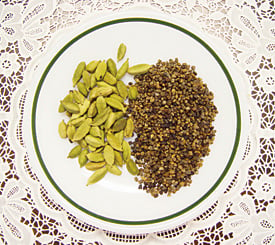 Arabic: Hal, Hail;
Arabic: Hal, Hail;
Other English: Cardamom, Lesser Cardamom, Small Cardamom, Malabar Cardamom Elettaria cardamomum; Zingiberaceae (Ginger Family)
Imagine an ancient trade caravan moving slowly up the Frankincense Trail in western Arabia toward the Mediterranean. The spices and aromatics burdening the camels could be from Yemen, East Africa, India or distant China. Although anticipating lucrative exchanges with merchants of the Mediterranean, caravaners also stop in villages along the way where both villagers and Bedouins are eager to barter. Exchanging goat meat, fresh produce or woven baskets, the local tradesmen obtain the cardamom necessary to flavor traditional Arabic coffee.
Native to India and Sri Lanka, cardamom is a well-loved spice in the Arabian Peninsula. Arab coffee is heavily flavored with it. In fact, cardamom is a valuable ingredient in Middle Eastern cuisine: in beverages, sweets, pastries and main dishes.
How to use: 1) Bruise cardamom pods until partially open; remove cardamom seeds from their pods; gently bruise seeds or dry-fry over gentle heat to release their flavor; or 2) Grind seeds into powder.
In the kitchen: Cardamom is a vital ingredient in Arabian coffee making. Its flavor can be added to the beverage by grinding cardamom pods and adding the powdered cardamom to already brewed coffee. Cloves, saffron, sugar, nakhwa (See page 19.) or rose water are also sometimes added for flavor. “Sweet coffee,” which doesn’t contain any coffee at all, is a traditional drink from the Hijaz. It is a wonderful, warm beverage with a pleasant cardamom flavor. It is served on special occasions such as graduation day, which is the day students receive their grade cards.
Remedies across Arabia: A member of the ginger family, cardamom is a carminative and a stimulant. It warms the body and helps relieve indigestion and gas.
Did you know?
- Cardamom is one of the most expensive spices in the world. This is because each individual fruit pod containing the desired seed spice must be harvested from its flower stalk by hand. Flower stalks must be carefully examined and re-examined as the fruit pods develop at different rates. Harvested while still green and firm, the pods are then dried and sold.
- About 1000 years ago, the Vikings discovered cardamom in their explorations and conquests around the Mediterranean. They introduced this spice to Scandinavia, where it is still used extensively in baking spiced cakes and breads.
- Cardamom was one of the most popular Oriental spices in ancient Roman cuisine.
- Ground cardamom can soften a plastic spoon left in it for several days.

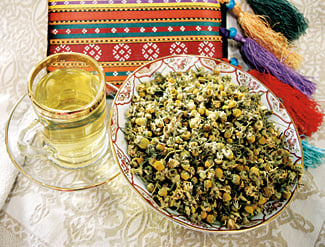 |
| LINDA LEBLING |
Arabic: Babunaj, Babunij;
Other English: Chamomile
German Chamomile: Matricaria recutita, Matricaria chamomilla
Saudi Chamomile: Matricaria aurea; Asteraceae (Aster Family)
One thing every Bedouin, villager and city dweller can tell you is that camomile tea is relaxing and aids digestion. Along with this fact comes the widespread belief that the best babunaj comes from the north. As a result, packaged herbal teas from Syria and Jordan are popular supermarket items. These medicinal teas feature camomile but may also contain coriander, black seed, anise, rose, lemon balm, hibiscus, thyme or sage.
How to use: Use the flower heads to brew a medicinal tea.
In the kitchen: Many families keep camomile readily available. To make camomile tea, boil water and then pour one cup of the water over four teaspoons of dried flowers. Infuse for five to 10 minutes and then strain. Add honey for a sweeter taste and drink the tea warm.
Remedies across Arabia: Camomile is a valued nervine, carminative and general tonic. Camomile tea is well-known for settling the stomach and aiding digestion after a meal. It is also relaxing and can help promote sleep
Did you know?
- In 1656, John Parkinson wrote, “Camomill is put to divers and sundry uses, both for pleasure and profit, both for the sick and the sound, in bathing to comfort and strengthen the sound and to ease pains in the diseased.”
- Al-Kindi used camomile in a strong dressing for the spleen and in an application to relax the liver and stomach.
- Camomile tea is used in the Levant to strengthen a mother after childbirth.
- Camomile is used in perfumes, soaps, bath oils, skin-care products and in shampoos to add luster to blonde hair.
- With a reputation as a mild bleach, camomile has been used to lighten blonde hair by pouring two cups of boiling water over a handful of camomile flowers and infusing for 30 minutes. After shampooing the hair, rinse several times with this camomile infusion while it is still warm. It is a very pleasant hair rinse.

Arabic: Khiyar Cucumis sativus; Cucurbitaceae (Gourd Family)

Cucumbers are produced on small farms throughout the Arabian Peninsula and sold in local fruit and vegetable markets. Cucumbers have long been known in eastern and western traditional medicine as one of the best natural diuretics. The effect is in the seeds, which are rich in sulfur, silicon and potassium.
Cucumbers originated in Asia, probably in India, and spread into Europe about 3000 years ago. Today Indian medicine prescribes cucumber juice for an array of ailments, including constipation, stomach disorders, urinary problems, rheumatism and even cholera.
How to use: 1) Slice or finely chop the cucumber to add to salads; 2) Slice, grate or mash the cucumber for use in skin-care applications.
In the kitchen: Middle Eastern cuisine would not be the same without the cucumber. Traditional salads, such as fattoush and tabbouleh, call for this fruit posing as a vegetable, as does the popular yogurt and cucumber salad, which complements and cools rice and meat dishes. Sliced cucumbers and tomatoes, drizzled with lemon juice and garnished with fresh mint and parsley, form the renowned cucumber and tomato salad. Arranged decoratively on a serving plate, it is a simple yet healthy choice.
Remedies across Arabia: Suparna Trikha, one of India’s leading natural beauty experts, advised that the juice made from cucumber skin can be a soothing lotion and skin cleanser. She also suggested grating cucumber and massaging the pulp into the skin and leaving it to dry. Splashing fresh water and gently wiping the face after 10 minutes or so is a good way to slow the advance of wrinkles. Additionally, cucumber slices are put on swollen eyes, to reduce the swelling.
Did you know?
- Cucumbers were a popular food in ancient Rome, and historian Pliny the Elder reports that the Emperor Tiberius ate large quantities.
- The cucumber is a fruit because it contains the seeds to reproduce. Botanically speaking, a fruit is the mature ovary of a plant, such as a cucumber, apple, melon or tomato.
- Cucumbers, along with squash, melons and pumpkins, belong to the group of vegetables known as cucurbits, or vine crops.

 Arabic: Luban;
Arabic: Luban;
Other English: Olibanum, Oil of Lebanon Boswellia sacra or B. carteri or B. thurifera; Burseraceae (Frankincense and Myrrh Family)
Frankincense is crystallized tree sap—a hardened gum or resin exuded by a small tree that grows in the coastal regions of the southern Arabian Peninsula and nearby coastal East Africa. In ancient times, frankincense was a precious commodity, sometimes more valuable than gold. Merchants brought this treasure to the great civilization centers of Europe and Western Asia by sea and by a land trail through Yemen and up the Arabian Red Sea coast to the Levant. In Saudi Arabia and other Gulf countries, frankincense is used as incense today, though not in religious ceremonies.
How to use: 1) Chew as a gum. This is a popular use as frankincense has a mild, pleasant taste and helps to eliminate bad breath. 2) Suck on a granule to relieve nausea; 3) Soak frankincense granules in water and drink the strained liquid; 4) Burn as incense for a pleasant scent or waft on clothing.
Did you know?
- Frankincense comes in five main colors: white, pale lemon, pale amber, pale green and dark amber. The color of the gum resin is influenced by its harvest time. A whiter gum is collected closer to autumn, whereas a darker color is harvested closer to spring.
- Although the frankincense gathering season lasts from May through mid-September, the product is available year-round in traditional local markets of the Middle East.
- Due to unique climatic conditions, the best frankincense is produced by trees growing in the mountainous Dhofar region of Oman. In addition to Oman, frankincense today is grown in Yemen, Ethiopia, Somalia and India.
- In the days of the pharaohs, frankincense trees were imported into Egypt, where they were grown for the gum, which was burned in religious rituals.
- Tenth-century Persian physician Ibn Sina (known to the West as Avicenna) recommended using frankincense in treatments for tumors, ulcers, vomiting, dysentery and fever.
- Frankincense today remains an ingredient in various incense mixtures burned in rituals of the Roman Catholic and Orthodox churches.
- Western herbalists regard frankincense essential oil as an anti-inflammatory, antiseptic and astringent, and say it is useful as a uterine tonic during pregnancy and labor.
- Charred frankincense has been used to make kohl, the black powder traditionally used by women in the Middle East to paint their eyelids.

Arabic: Thum, Thoom Allium sativum; Alliaceae (Onion Family)
Botanist David Hooper, in his survey of useful plants in Iran and Iraq in the 1930’s, observed that garlic was the potherb par excellence of the East—not only was it used in a dizzying array of culinary dishes, but it also aided digestion and was a gastric stimulant. If anything, Hooper’s comment was an understatement. We now know garlic has a wealth of other medicinal properties to complement its enduring value as a cooking herb.
Garlic, a bulbous perennial, probably originated in Central Asia, the only place where it grows wild. (There are other plants in other lands referred to as “wild garlic”; they are part of the Allium genus but are not true garlic, A. sativum. Garlic has edible flowers but it is primarily grown for its bulbs, each of which contains 12 to 20 cloves. Garlic has been cultivated by humans from time immemorial. Hundreds of varieties have spread out from Asia to encompass the globe.
 How to use: 1) Crush, chop or use garlic cloves whole to flavor dishes; 2) Bake, roast or grill a bulb of garlic. When softened, squeeze out the pulp from the individual cloves to eat; 3) Mash the softened pulp of baked garlic to form a smooth paste and use it in soups, sauces and dips. Alternatively, grind fresh garlic to a paste with a mortar and pestle.
How to use: 1) Crush, chop or use garlic cloves whole to flavor dishes; 2) Bake, roast or grill a bulb of garlic. When softened, squeeze out the pulp from the individual cloves to eat; 3) Mash the softened pulp of baked garlic to form a smooth paste and use it in soups, sauces and dips. Alternatively, grind fresh garlic to a paste with a mortar and pestle.
In the kitchen: Garlic is a much appreciated ingredient in both hummus bi tahina (chickpea and sesame puree) and baba ghannouj (eggplant and sesame puree), two popular dips with Arab bread.
When frying, use enough olive oil or butter to coat the pan and stir often. Garlic burns quickly if cooked over high heat.
Store garlic in a cool, dark pantry. Garlic stored in the refrigerator quickly dries out and rots.
Remedies across Arabia:
- Use garlic for ant bites. (Northern Province)
- Use a clove of garlic to relieve the pain of a bee sting. (United Arab Emirates)
- Use an ointment made of ground garlic on a wound even if it hurts, since this prevents gangrene. Also, you can clean wounds by mixing ground garlic in warm water and washing the wound with it to kill the microbes. (Eastern Province)
- Rub a raw garlic clove on the spot where a scorpion stings you, and it will heal. (Eastern Province)
- My grandmother used garlic to kill warts and prevent them from reappearing. (Bahrain)
Did you know?
- The Greek historian Herodotus, during a tour of Egypt, reported seeing an inscription on the Great Pyramid at Giza that recorded the quantities of radishes, onions and garlic consumed by the laborers who constructed it.
- According to tradition, the Prophet Muhammad recommended garlic, applied topically, to remedy viper bites and scorpion stings.
- Al-Kindi, the medieval Arab physician, used garlic in a drug for treating earaches and other diseases of the ear.
- Despite garlic’s known antibiotic activity, and despite Internet rumors to the contrary, there have been no scientific studies showing garlic has any effect against anthrax.

Arabic: Murr, Murrah Commiphora myrrha or C. molmol or Balsamodendron myrrha; Burseraceae (Frankincense and Myrrh Family)
Myrrh is collected from the stems of bushy shrubs found growing in southern Arabia and Somalia. A granular secretion exits the stem through natural fissures, or cuts, as a pale yellow liquid. It then hardens to a reddish-brown mass. It can be found in different sizes in the marketplace, most pieces being the size of large marbles or walnuts.
 |
| FALEH AL-KHASHRAM |
The word myrrh means “bitter” in Arabic. Myrrh is one of the best antiseptics known, an astringent and a stimulant.
How to use: 1) Soak myrrh granules in water for two to three days and then drink the strained liquid; 2) Swallow small granules like pills; 3) Burn as incense.
Remedies across Arabia:
- Although it doesn’t taste very good because it is so bitter, myrrh is used to alleviate inflammation in the body.
- Myrrh water is an excellent mouthwash and is helpful for mouth sores or blisters, sore throats, bronchial congestion and other conditions requiring an antiseptic astringent.
- For burns, soak myrrh in a small amount of water. It is put on burns to reduce scars and to help in quickly healing wounds and to remove warts. (Southern Province)
- In the past, myrrh oil was wiped on a new baby’s navel. (Bahrain)
- Myrrh is very good to have if you have external cuts. It makes them get better quickly. (Central Province)
- We use myrrh for so many uses, for example to treat sores, appendicitis pain after operation, boils, stomach aches and the colon. Soak myrrh stones in water. Then place the water on the area of pain for boils, or drink it. (Central Province)
- Myrrh is used to help healing of wounds, minor burns and wounds of simple surgical operations. (Southern Province)
Did you know?
- Ancient Egyptians wore unguent cones saturated with myrrh, marjoram, sweet flag or lotus. They put the cones on their heads in the morning, and as the day grew hot, the cones would slowly melt, running down the body, keeping the skin moist and repelling insects throughout the day.
- Myrrh is an oil referenced throughout the Old and New Testaments. The Arabian people used it for many skin conditions, such as wrinkled, chapped and cracked skin. It has one of the highest levels of sesquiterpenes, a class of compounds that has direct effects on the hypothalamus, pituitary and amygdala, the seat of our emotions. Myrrh is widely used today in oral hygiene products.
- The Muslim physician al-Razi (Rhazes), perhaps the greatest of all medieval clinicians, used myrrh to treat ailments of the kidneys and bladder, to dissipate swellings in the stomach and for colic.
- In Egypt today, traditional medicine practitioners use myrrh as a stimulant, expectorant, antispasmodic, emmenagogue, antiputrescent and astringent. It is also used to treat dental caries and inflamed gums.
- Myrrh is a fixative, meaning it increases the longevity of the aroma of any fragrance it is combined with but doesn’t dominate or overpower that fragrance.
- Scientific tests have shown myrrh to possess significant antibacterial and anti-inflammatory properties.

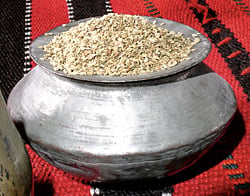 |
| STEPHEN L. BRUNDAGE |
Arabic: Nakhwa, Nankha or Nanakhwah; Hindi: Ajwain or Ajowan;
Other English: Bishop’s-Weed Trachyspermum ammi, Carum ajowan, Carum copticum, Ammi copticum Umbelliferae/Apiaceae (Carrot/Celery/Parsley Family)
Used as medicine by the ancient Greeks and Arabs, nakhwa is still considered a natural remedy. You can buy the aromatic seeds as well as a distillate.
How to use: 1) Release the aroma of the seeds before use by rubbing between your fingertips, crushing with a mortar and pestle or gently stirring while warming in a frying pan; 2) Use seeds whole or grind them into powder form.
In the kitchen: Nakhwa is sometimes added to traditional Arab coffee. In addition to providing a unique flavor, it is believed to soften the impact of coffee on the stomach and reduce the effects of caffeine. In fact, some people across Arabia drink nakhwa as a substitute for Arab coffee to totally eliminate negative coffee effects.
Did you know?
- Like black seed (Nigella sativa), nakhwa is a popular ingredient in many herbal medicinal blends.
- The ancient Sumerians described nakhwa as a “plant of the mountain.”
- Nakhwa is grown in Pakistan, Afghanistan, Iran, India and Egypt.
- Though more commonly cultivated today in Asia, nakhwa is actually of African origin, and some Arabs call it “Ethiopian cumin” (al-kammun al-habashi).
- Al-Kindi (ca. 800–870) used nakhwa in a preparation for hemorrhoids.
- Nakhwa seeds yield 40 to 55 percent thymol, a valuable crystalline phenol extracted for medicinal purposes.
In the West, thymol is used in some cough medicines.

Arabic: Naft, Batrul
Although few people are aware of it today, petroleum was once considered an effective natural remedy not only in the Middle East but in many parts of the world. Oil upwellings and gas vents were known anciently in present-day Kuwait, Iraq, Iran, Azerbaijan, Turkmenistan and Uzbekistan. Natural deposits of thickened petroleum (also called “bitumen”) seeped from openings on land or floated to the surface of lakes. It was easy to gather and was used as a building material, waterproofing material, lubricant, adhesive, medicine, fuel, illuminant and fumigant, and even as a weapon.
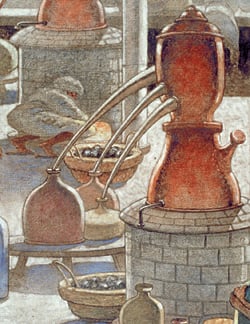 |
| BOB LAPSLEY |
How to use: The All-Encompassing Dictionary (Al-Qamus al-Muhit), written in Makkah in the 15th century by Abu Tahir al-Fayruzabadi, a scholar of Persian descent, reveals that oil was commonly sold as medicine and as a fuel for lighting, and that it was used as an incendiary in a type of military flame thrower.
In the kitchen: Petrolatum—a neutral, odorless, tasteless unguent distilled from petroleum and then purified—is sometimes used in bakery products as a release agent. Petrolatum meets modern us Food and Drug Administration requirements for medicinal, cosmetic-formula and animal-feed use, and is also approved for direct contact with food.
Remedies across Arabia: Descriptions of petroleum’s healing powers date from 2000 years ago, although its traditional medicinal use is probably much older. Oil-and-water baths were supposed to strengthen the body. Ointments of bitumen and other chemicals were often applied to sores or broken bones. Other petroleum preparations acted as antidotes to poison, fumigants, disinfectants or laxatives.
The Book of the Powers of Remedies, a medical text prepared by Masarjawah, a prominent physician living in Basra, Iraq, during the seventh century, described the benefits of ingesting oil for fighting disease and infection. Masarjawah wrote: “Warm naphtha, especially water-white naphtha, when ingested in small doses, is excellent for suppressing cough, for asthma, bladder discomfort and arthritis.”
The All-Encompassing Dictionary states, “The best grade of naphtha is the water-white. It is a good solvent, a diluent and an expectorant. Taken internally, it relieves cramps and aches of the belly, and, when applied topically, it can soothe skin rashes and infections.”
Vicks VapoRub, a nasal decongestant, cough suppressant and topical analgesic, contains petrolatum, and other salves, suppositories and cosmetic products also benefit from the consistency contributed by petrolatums.
Did you know?
- Akkadian clay tablets from about 2200 BC referred to crude oil as naptu, from which derives the root of the Arabic naft.
- William Rockefeller, father of John D. Rockefeller, sold bottles of raw petroleum to country folk as a cure for cancer.
- Petroleum is used today in homeopathic medicine to treat motion sickness, eczema and other skin problems, nausea and diarrhea.

Arabic: Rumman Punica granatum; Lythraceae/ Punicaceae
 |
| STEPHEN L. BRUNDAGE |
While native to Iran and its neighboring countries, the pomegranate was cultivated in ancient times all around the Mediterranean and throughout the Arabian Peninsula. It is a deciduous tree or large shrub that produces excellent fruit under semiarid conditions.
How to use: 1) Eat the fleshy seeds to enjoy a delicious, slightly tart flavor; 2) Dry the seeds and use in cooking; 3) Extract the juice from the seeds for a refreshing drink or as a flavoring agent in cooking; 4) Dry the outer peelings and crush them for culinary, cosmetic or medicinal purposes. 5) Boil pomegranate peelings in water, then strain and drink the liquid; if more concentrated, the liquid can be used as a dye for clothes; 6) Dry the peelings, then grind and mix with henna to make it darker and provide skin nourishment.
In the kitchen: Pomegranate seeds have a sweet-sour taste. Crushed or whole, they often garnish salads, couscous, hummus and other Middle Eastern dishes. Dried pomegranate seeds and pomegranate syrup are also popular in cooking. Pomegranate juice is a refreshing drink on hot summer days. Pomegranate juice stains indelibly, so it’s wise to wear protective clothing when cooking with it.
Remedies across Arabia: Powdered pomegranate peelings are used on burns and to treat infection on external cuts and wounds. Soaked pomegranate peelings are used for sore throats, stomach aches and indigestion. To treat indigestion, pomegranate peelings are dried, then boiled, and the water drunk. Rose water can be added for flavor. Pomegranate soaked in boiled water is used with honey for heart trouble.
Did you know?
- Pomegranate seeds are rich in vitamin C and are a good source of dietary fiber.
- Commercially produced pomegranate syrup is called grenadine.
- The Romans called the pomegranate fruit punicum, the Latin name for Carthage, because they believed that the best pomegranates came from there.
- The Spanish name for the pomegranate is granada, and its fruit appears on Granada’s city seal.
- Pomegranate is believed to be the inspiration for the hand-tossed explosive called a grenade. When a pomegranate is dropped on a hard surface, it bursts and seeds are tossed everywhere. The military borrowed the modern French name for the fruit, grenade.

Arabic: Za’faran, Za’fran Crocus sativus; Iridaceae (Iris Family)
 |
| LINDA LEBLING |
Saffron refers to the dried, red stigmas collected from the flowers of Crocus sativus. Its high price is better understood when we learn that some 75,000 flowers are required to make one pound of dried saffron. Commercial producers of saffron today include Spain, Iran and India. Native to the Middle East, saffron was introduced to Europe by the Muslim Arabs and Berbers of northwest Africa, who conquered most of Spain in the eighth century. From Spain, known as al-Andalus to the Arabs, saffron was carried to Italy and France, where it became popular. Although not completely new to the British Isles, saffron was brought back to England by the crusaders of the 13th century. Historically, saffron has been used for medicine, perfume, dye and as a cooking spice.
How to use: The stigmas produce a bright yellow or orange color when added to water. If a recipe requires ground saffron, one can crush or grind it to a powder. Be sure it is evenly distributed when added to the recipe. Sifting the ground saffron with the dry ingredients is one way to insure a good mix. If using whole saffron threads, soak them for about 10 minutes in a warm liquid required by the recipe, such as milk, water or broth. The color and flavor of the stigmas will be released into the liquid. A pinch of saffron to a cup of liquid yields enough color and flavor for about half a kilo (1 lb) of rice. A little saffron goes a long way.
In the kitchen: Saffron can add taste and color to breads, chicken and rice dishes.
Did you know?
- Comparing the beauty of his beloved to a garden, Solomon (The Song of Solomon 4:14 in the Old Testament) lists saffron, cinnamon, frankincense and myrrh as some of the plants cultivated in this metaphor. We sense the magnitude of his admiration because these plant products commanded very high prices in ancient markets.
- Today, saffron remains the most expensive spice in the entire world.
- Scholars studying frescoes at Thera, a Greek island in the Aegean, believe the wall paintings (dating from 1500 or 1600 BC) depict a goddess presiding over the manufacture and use of a drug from the saffron flower. This suggests that saffron has been used as a medicine for at least 3500 years.

Arabic: Za‘tar, Sa‘tar, Hasha’ Thymus vulgaris; Lamiaceae (Mint Family)
When dining in the Middle East, it is customary to dip bread in olive oil and then in za‘tar for a delicious taste. Although za‘tar is the word for thyme in the Arabic language, it is also a term which describes a Middle Eastern spice blend of powdered dried thyme, sumac and sesame seeds. Each region makes za‘tar a little differently.

How to use: 1) Use fresh green thyme leaves when called for in recipes; 2) Use dried thyme leaves as part of the aromatic spice blend called za‘tar; 3) Sprinkle za‘tar (fresh thyme or the spice blend) on meatballs or vegetables; 4) Use the za‘tar spice blend with olive oil as a dip for bread.
In the kitchen: Flat breads with toppings of melted cheese and za‘tar, labna and za‘tar, or za‘tar alone are unspeakably delicious. Store za‘tar in an airtight container away from direct light.
Remedies across Arabia: A general remedy for colds, flu, fevers, coughs and bronchitis is to take four to five cups of thyme tea a day. Thyme is antiseptic, antispasmodic and antifungal. It is also an expectorant and vermifuge (worm expeller).
Did you know?
- Five millennia ago, the Sumerians used thyme as an antiseptic.
- The ancient Egyptians employed thyme as an ingredient in the mummification process.
- The Arab philosopher-scientist al-Kindi (800–870) used thyme in a medicine to treat a bacterial infection or rash called St. Anthony’s Fire (erysipelas).
- The Islamic physician al-Razi (865–925) regarded thyme as an appetite enhancer, stomach purifier and treatment for flatulence.
- Thyme is widely grown commercially for its leaves and essential oils.
- Thyme is one of a small number of herbs that have more flavor dried than fresh. Others are rosemary and oregano.

Arabic: Kurkum Curcuma longa, C. domestica; Zingiberaceae (Ginger Family)
Often called “Indian saffron,” turmeric rhizome was one of the ancient trade products brought by sea from India. Today turmeric is widely used as a spice, cosmetic and dyestuff, and remains part of traditional medicine from Egypt to Iran.
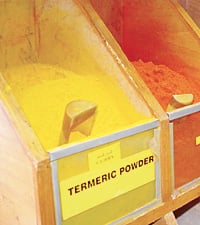 How to use: 1) Slice, grate, chop or grind turmeric to a paste with other ingredients. Then use it as you would fresh ginger root; 2) Grind dried turmeric into powder; 3) Use whole pieces of dried turmeric in pickling.
How to use: 1) Slice, grate, chop or grind turmeric to a paste with other ingredients. Then use it as you would fresh ginger root; 2) Grind dried turmeric into powder; 3) Use whole pieces of dried turmeric in pickling.
In the kitchen: Slicing a piece of turmeric rhizome reveals the deep yellow color used to brighten curry powders and a variety of foods. When coloring rice dishes, it is also sometimes a substitute for saffron. But it is easier to buy ready-ground turmeric than to grind it yourself. Wear rubber gloves when handling fresh turmeric to avoid staining your hands.
Did you know?
- In Indian cuisine, turmeric is an ingredient of virtually all curry powders.
- Because turmeric is an edible coloring, the food industry uses it to color mustard, butter, cheese and liqueurs.
- Turmeric is used to dye cotton and silk.
- Al-Kindi used turmeric in a medicine for throat and mouth pustules, and in a dentifrice to strengthen the gums.
- The US Patent and Trademark Office

Arabic: Deerum Juglans spp.; Juglandaceae (Walnut Family)
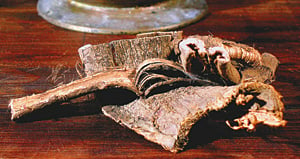 |
| STEPHEN L. BRUNDAGE |
A container filled with thin bark strips folded up and tied into bundles is another curiosity at a traditional market. Although not widely used nowadays, it is a reminder of the traditional self-reliance and ingenuity of peoples of the Arabian Peninsula during times of more limited resources.
How to use: 1) Chew the end of the bark until soft; 2) Rub the bark vigorously on lips for a natural dark brown lipstick; 3) Use the bark as a toothbrush to clean teeth and gums.
Remedies across Arabia: The bark of the walnut tree is astringent and cleansing. It strengthens the gums and acts as an anti-inflammatory. It has been used to treat gum disease.
Did you know?
- Pliny reported that walnut trees were introduced into Italy from Persia, and Varro, who was born in 116 BC, mentioned that walnut trees were growing in Italy during his lifetime.
- Walnut bark is a traditional source of yellow-brown dye.
 |
Robert Lebling is a writer/editor and communications specialist. He heads Saudi Aramco’s electronic publishing team and its international media relations group in Dhahran. He studied politics and anthropology at Princeton. He has lived in Egypt, Lebanon and the UK, and worked as a journalist in the Middle East and in Washington, D.C. His Web site address is www.geocities.com/eyeclaudius.geo. |
 |
Donna Pepperdine is an ESL instructor with a special interest in literacy, culture and health education. As a master herbalist, she has focused much of her research on natural health solutions within the context of the Saudi family. Donna has lived in the Middle East 10 years. Her Web site address is www.herbaleducator.com. |